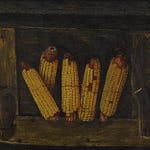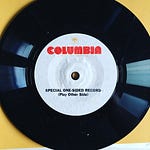Near the end of Nirvana's MTV Unplugged concert in 1993, Kurt Cobain tells the audience that someone from the Lead Belly estate offered to sell him one of the legendary musician's guitars for half-a-million dollars. The audience laughs. Cobain says he asked label boss David Geffen to buy it for him. Then he goes into a cover of "Where Did You Sleep Last Night," a song Lead Belly made famous.
Twenty-seven years later1, the guitar Cobain held while he told the story (it was not Lead Belly’s) sold for six million dollars. That's the equivalent of just under three-and-a-half million dollars in 1993 money. The buyer was the founder of a famous microphone company.
This year, the guitar Cobain played in the "Smells Like Teen Spirit" video sold at auction for over four million dollars, or about two million dollars in 1993 money. The buyer, Jim Irsay, added it to his extensive collection of rock memorabilia. He also owns the Indianapolis Colts.2
Someone more steeped in the grunge ethos might be able to elaborate on the spiritual implications of an instrument so associated with a particular punk-adjacent musical movement fetching such a high price. I'm more interested in what it means for rock music as a genre to see Cobain's guitar next to items like Ringo's drums.
With art auctions, there's an expectation a big purchase will accrue in value. I don't see rock star guitars as investment properties, at least not long-term. Many guitars are beautiful objects, but they're not art in and of themselves, at least not the way a painting is. There are millions of Fender Mustangs out there (I have one). They all look and sound generally the same; they're mass-produced electric instruments, not Stradivarius violins. Like a painter's brushes, the value of famous guitars is in what was done with them, or how close they were to someone who matters to us. That value might mean a lot of money in the short term, but it becomes sentiment in the long term. Cobain's guitars will be most valuable to people who are reverent of rock music in general and grunge in particular.
Memorabilia like rockstars' guitars are artifacts. They're things we go see in a history museum. That's where Lead Belly's guitar is (or at least where one of them is). It's where Cobain's Mustang is likely to end up, as Irsay hopes to establish a museum.
Most things in history museums are, by necessity, not being used. The event they were part of (even if it was very recent) is over, and the object is there to give us an idea of what that time was like.
Nirvana was, likely, the last big rock band. They weren't the last famous rock band. They weren't the last good rock band. They weren't the last important rock band. But Nirvana was the last rock act to be singularly associated with the idea of rock music. If you were making a television show or movie that was set in the 1990s and you had a character who was a fan of rock music, they would undoubtedly listen to music performed by or inspired by Nirvana, and they would wear clothes inspired by the clothes Nirvana wore.
The Rock and Roll Hall of Fame—rock music's museum to itself—basically ends rock history with Nirvana. Artists are eligible for induction 25 years after their debut album. Nirvana was inducted in 2014, their first year of eligibility. Every rock act inducted since then either predated Nirvana (The Cars, Roxy Music, Dire Straits, Yes...somehow) or were the band's contemporaries (Pearl Jam, Green Day, Nine Inch Nails). And only two rock acts to follow Nirvana into the hall put out their first record after Nirvana's breakthrough, Nevermind. One is Radiohead, who formed in the '80s, and the other is Foo Fighters, formed by Nirvana drummer Dave Grohl. According to the Hall of Fame, no other rock act to debut between 1993 and 1998 has built up enough of a career to warrant telling future generations about them.3
The story of the Hall since Nirvana is largely the story of the genre that replaced rock in the mainstream around the time Nevermind dropped: Hip-hop. Jay-Z, NWA, Tupac, Notorious B.I.G., and Eminem beat any other '90s acts to the Hall.
The sale of Cobain's guitar closes a door on rock music. It's been more than 30 years since "Smells Like Teen Spirit" and the only other guitar that might be considered nearly as iconic belonged to Prince, a brilliant musician whose work spans genres but would never be singularly labeled "rock."4
The rock genre, like the guitar, is a museum piece. It's in its mothball stage and holds its value as a piece of history, a spark for inspiration, or as a collectible for people with plentiful enough money and specific enough taste.
Before Irsay starts his museum, he's taking his collection to various cities across the U.S. It's the last rock tour.
It's a coincidence the number 27 appears here, given Cobain's association with the rumored "curse" of famous musicians dying at 27: Cobain, Robert Johnson, Janis Joplin, Jimi Hendrix, Jim Morrison, Chris Bell, "Pigpen," D. Boon, Amy Winehouse, to name a few. And I'm placing Unplugged in 1993 because that's when the concert was recorded. The album came out the following year.
I asked for an interview with someone from the Irsay Collection, but they declined after asking how many subscribers I have. So…tell some friends about this and maybe I can get an interview.
Of rock bands to debut after Nirvana, it's hard to imagine the Hall's voters being excited about anyone except maybe the White Stripes.
One of Prince's guitars is also in the Irsay collection.















Share this post